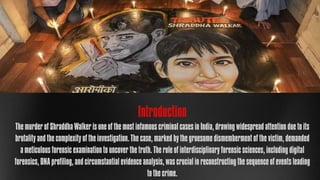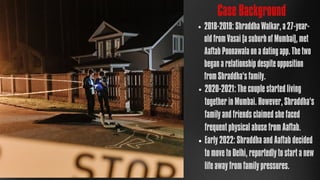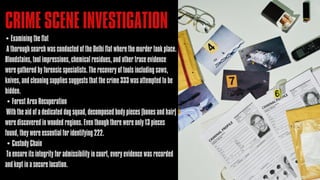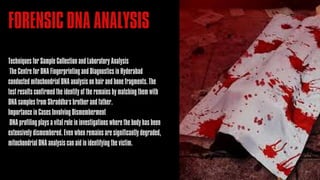Shraddha Walkar's Murder Case Review.pdf
- 1. SHRADDHA WALKAR BY: C166 AMAN KHATRI C180 RISHIRAJ PARMAR C187 JAY KANANI C192 AAYUSH SAVLA C193 NIMIT DOSHI The Murder OF
- 2. Introduction The murder of Shraddha Walker is one of the most infamous criminal cases in India, drawing widespread attention due to its brutality and the complexity of the investigation. The case, marked by the gruesome dismemberment of the victim, demanded a meticulous forensic examination to uncover the truth. The role of interdisciplinary forensic sciences, including digital forensics, DNA profiling, and circumstantial evidence analysis, was crucial in reconstructing the sequence of events leading to the crime.
- 3. Shraddha Walker (Victim): A young woman who was allegedly murdered in cold blood. Her tragic death became a high-profile case due to the gruesome nature of the crime and the complexities involved in the investigation. Aaftab Poonawala (Accused): The prime suspect in the case and ShraddhaŌĆÖs live-in partner. He was accused of brutally murdering Shraddha, dismembering her body, and attempting to conceal the crime through calculated methods. His digital and behavioral patterns became crucial in forensic analysis. Investigative Authorities: The Delhi Police, forensic experts, and legal teams played a significant role in piecing together the evidence. Their work, which included DNA matching, analysis of digital traces, and examination of circumstantial evidence, was instrumental in building the case. KEYINDIVIDUALSINVOLVED
- 4. Case Background 2018-2019: Shraddha Walkar, a 27-year- old from Vasai (a suburb of Mumbai), met Aaftab Poonawala on a dating app. The two began a relationship despite opposition from ShraddhaŌĆÖs family. 2020-2021: The couple started living together in Mumbai. However, ShraddhaŌĆÖs family and friends claimed she faced frequent physical abuse from Aaftab. Early 2022: Shraddha and Aaftab decided to move to Delhi, reportedly to start a new life away from family pressures.
- 5. TIMELINE May 15-17, 2022: The couple had frequent arguments over financial issues and ShraddhaŌĆÖs insistence on marriage. Their fights reportedly turned violent. May 18, 2022 (Day of Murder): A major argument escalated, and Aaftab allegedly strangled Shraddha to death inside their rented flat in Chhattarpur, Delhi. After realizing what he had done, he planned to dispose of the body to evade suspicion. May 19-20, 2022: Aaftab purchased a 300-liter refrigerator to store ShraddhaŌĆÖs dismembered body. He used a saw and knives to cut her body into over 30 pieces. He started disposing of the parts in various locations, primarily in Mehrauli forest and Chhattarpur. May 20 - June 5, 2022: For 18 days, Aaftab systematically disposed of the body parts late at night to avoid detection. He used air fresheners and incense sticks to mask the odor of decomposition. June 2022 - October 2022: ShraddhaŌĆÖs family tried to contact her but received only WhatsApp messages, which were later suspected to have been sent by Aaftab to mislead them. Friends grew suspicious as Shraddha was not posting on social media.
- 6. ŌĆó Examining the flat A thorough search was conducted of the Delhi flat where the murder took place. Bloodstains, tool impressions, chemical residues, and other trace evidence were gathered by forensic specialists. The recovery of tools including saws, knives, and cleaning supplies suggests that the crime 333 was attempted to be hidden. ŌĆó Forest Area Recuperation With the aid of a dedicated dog squad, decomposed body pieces (bones and hair) were discovered in wooded regions. Even though there were only 13 pieces found, they were essential for identifying 222. ŌĆó Custody Chain To ensure its integrity for admissibility in court, every evidence was recorded and kept in a secure location. CRIME SCENE INVESTIGATION
- 7. FORENSIC DNA ANALYSIS Techniques for Sample Collection and Laboratory Analysis The Centre for DNA Fingerprinting and Diagnostics in Hyderabad conducted mitochondrial DNA analysis on hair and bone fragments. The test results confirmed the identity of the remains by matching them with DNA samples from Shraddha's brother and father. Importance in Cases Involving Dismemberment DNA profiling plays a vital role in investigations where the body has been extensively dismembered. Even when remains are significantly degraded, mitochondrial DNA analysis can aid in identifying the victim.
- 8. EVIDENCES Digital Forensics and Electronic Evidence Social Media and Mobile Data Analysis Investigators examined the phone records of both the accused and the victim. AaftabŌĆÖs claim that Shraddha had left earlier was contradicted by evidence showing her phone remained active until May 29, 2022. Additionally, social media activity, including an Instagram chat linked to her, further confirmed her presence in Mehrauli during the relevant timeframe. Financial Transactions as Digital Evidence A transaction of Ōé╣54,000 from ShraddhaŌĆÖs bank account to AaftabŌĆÖs indicated continued financial interaction after her alleged disappearance. These digital footprints played a crucial role in reconstructing the timeline of the crime. Behavioral Analysis: Narco-Analysis and Polygraph Tests Narco-Analysis Examination Aaftab revealed information regarding how the body was disposed of and the instruments used during his narco- analysis. These disclosures led investigators to support physical evidence, even though it was not admissible in court 444. ŌĆó Polygraph test and post-narco interview He apparently confessed to the murder after undergoing a polygraph test as well. These tests provided information about the suspect's mental state and produced more investigative leads, despite their restricted legal admissibility.
- 9. PHYSICALAND CHEMICAL EVIDENCES The forensic analysis confirmed that the cut marks on the discovered bones matched the characteristics of the saw and knives found in the flat, aligning with the accused's statements. Additionally, the presence of cleaning products in the flat suggested attempts to eliminate blood and other forensic evidence.
- 10. LEGAL FRAMEWORKS Direct versus circumstantial evidence Because there were no eyewitnesses, circumstantial evidence took the stage. To create a coherent story, investigators used a mix of digital documents, DNA results, tool marks, and behavioural analysis. ŌĆó The Indian Evidence Act's legal standards Evidence must be pertinent and connected, according to Sections 5 and 6 of the Indian Evidence Act. When circumstantial evidence clearly leads to the accused 555, it can be used as sufficient evidence for conviction, according to landmark decisions (such as Ashok Kumar v. State and Chenga Reddy v. State).
- 11. ŌĆó The Times of India Report highlighted a charge sheet that was more than 3,000 pages long and included testimonies from witnesses and forensic and technological evidence. ŌĆó New Indian Express & ABP Live Important DNA confirmations were revealed by ABP Live 333, and The New Indian Express detailed the post-narco study, pointing out contradictions in Aaftab's claims . MEDIA AND NESWPAPER REPORTS ŌĆó The Financial Times centred on the public outcry following the victim's father's cardiac arrest news and his crusade against domestic abuse 666. ŌĆó Public Reaction: News reports sparked national indignation and discussions about forensic science, domestic abuse, and the difficulties in solving crimes involving dismemberment.
- 12. Digital Forensics and Electronic Evidence Social Media and Mobile Data Analysis Investigators examined the phone records of both the accused and the victim. AaftabŌĆÖs claim that Shraddha had left earlier was contradicted by evidence showing her phone remained active until May 29, 2022. Additionally, social media activity, including an Instagram chat linked to her, further confirmed her presence in Mehrauli during the relevant timeframe. Financial Transactions as Digital Evidence A transaction of Ōé╣54,000 from ShraddhaŌĆÖs bank account to AaftabŌĆÖs indicated continued financial interaction after her alleged disappearance. These digital footprints played a crucial role in reconstructing the timeline of the crime.
- 13. OPINION The Shraddha Walker murder case underscores the critical role of forensic science in bridging gaps within criminal investigations. From both an academic and investigative standpoint, the case highlights how forensic techniques contribute to solving complex crimes, particularly when conventional evidence is scarce or fragmented. A key takeaway from this case is the reliance on circumstantial evidence, which demonstrates the legal systemŌĆÖs adaptability in addressing modern-day criminal challenges. Although digital and DNA evidence played a crucial role in the investigation, it was the systematic integration of multiple forensic methodologies that helped construct a cohesive narrative. Moreover, the case exemplifies the effectiveness of advanced investigative techniques and meticulous chain-of-custody management in reconstructing even the most fragmented cases. The careful collection, preservation, and analysis of forensic evidence ensured that crucial details were not overlooked, ultimately leading to a clearer understanding of the crime. This case serves as a testament to the evolving nature of criminal investigations, emphasizing the indispensable role of forensic science, legal adaptability, and investigative diligence in delivering justice.
- 14. CONCLUSION The Shraddha Walker case serves as an example of how a comprehensive forensic investigation, including digital footprints, behavioural testing, and physical evidence, may create an engaging story for the prosecution. The effective mitochondrial DNA matching, phone log analysis, and narco/psychological testing demonstrate how science and law enforcement can work together. Furthermore, the widespread media coverage generated public debates on domestic abuse and the possibilities of forensic science, which may lead to changes in the legal system and a greater understanding of the issue.
- 15. THANKYOU!














